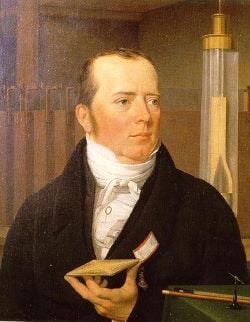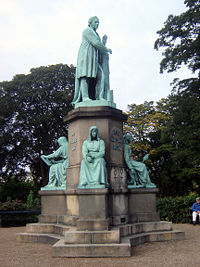Hans Christian Ørsted
| Hans Christian Ørsted |
|---|
| Born |
| August 14, 1777 Rudkøbing, Denmark |
| Died |
| March 9, 1851 Copenhagen, Denmark |
Hans Christian Ørsted (spelled Oersted when the Danish letter Ø is unavailable) (August 14,1777 – March 9, 1851) was a Danish physicist and chemist, influenced by the thinking of Immanuel Kant. He is best known for discovering the relationship between electricity and magnetism known as electromagnetism.
Early life and studies
Ørsted developed his interest in science while working as a young boy for his father, Søren Christian Ørsted, who owned a pharmacy. He and his brother, Anders Sandøe Ørsted, received most of their early education through self-study at home, and went to Copenhagen in 1793 to take entrance exams for Copenhagen University. The brothers passed and distinguished themselves academically at the University. In 1797, Oersted won a gold medal from the university for a paper, On the Limits of Poetry and Prose. The next year, he captured still another prize for a paper on a medical topic, and passed his pharmaceutical examinations. He was awarded a doctorate in 1799 for his dissertation, The Architectonicks of Natural Metaphysics.
In 1801, Oersted began investigations with the newly invented electric battery of Alessandro Volta, and published some observations on acids and alkali generated by an electric current.
The same year, he received a travel scholarship and public grant that enabled him to spend three years traveling in Europe. In Germany, he met Johann Ritter, a physicist who believed there was a connection between electricity and magnetism. The connection made sense to Ørsted since he believed in the unity of nature and that a relationship therefore must exist between most natural phenomena.
Their conversations drew Ørsted into the study of physics, and Oersted translated one of Ritter's works into French as a favor.
Oersted was unable to immediately obtain a chair in physics, but continued his experiments and lectures, receiving a grant from the state for this purpose. It wasn't until 1806, however, that he was offered and accepted a professorship at Copenhagen University. There he continued his research with electric currents and acoustics. Under his guidance the University developed a comprehensive physics and chemistry program and established new laboratories.
In 1809, Oersted published the first edition of the Manual of Mechanical Physics. The work was updated in 1844.
He took another excursion about Europe in 1812-1813, and published Views of the Chemical Laws of Nature. Upon his return in 1814, he married. He and his wife would become the parents of three sons and four daughters. in the remaining years of the decade, he continued to lecture, while furthering his investigations into electricity.
Electromagnetism
Oersted long believed that some connection would be found between electricity and magnetism. He observed, for example, that a bolt of lightning can change the poles of a compass. He also noted that an electric current produces light and heat in a wire. He felt that a mroe substantial connection between electricity and magnetism would eventually be uncovered.
While preparing for an evening lecture, Ørsted wanted to show the possible connection between electricity and magnetism. The success of his demonstration was a surprise to him. As he was setting up his materials, he noticed a compass needle deflected from magnetic north when the electric current from the battery he was using was switched on and off. This deflection convinced him that magnetic fields radiate from all sides of a wire carrying an electric current, just as light and heat do, and that it confirmed a direct relationship between electricity and magnetism.
At the time of discovery, Ørsted did not suggest any satisfactory explanation of the phenomenon, nor did he try to represent the phenomenon in a mathematical framework. However, three months later he began more intensive investigations. Soon thereafter he published his findings, proving that an electric current produces a magnetic field as it flows through a wire. The CGS unit of magnetic induction (oersted) is named in honor of his contributions to the field of electromagnetism.
In a later work, he described the effect of the current in a wire and the magnetic effect it produces:
"When opposite electrical powers meet under circumstances which offer resistance, they are subjected to a new form of action, and in this state they act upon the magnetic needle in such a manner that positive electricity repels the suth, and attracts the north pole of the compass; and negative electricity repels the north, and attracts the south pole; but the direction followed by the electrical powers in this state is not a right line, but a spiral one, turning from the left hand to the right."
His findings resulted in intensive research throughout the scientific community in electrodynamics. They influenced French physicist André-Marie Ampère's developments of a single mathematical form to represent the magnetic forces between current-carrying conductors.
(Ørsted was not the first person to discover that electricity and magnetism are related. He was preceded in this discovery by 18 years by Gian Domenico Romagnosi, an Italian legal scholar. An account of Romagnosi's discovery was published in 1802 in an Italian newspaper, but it was overlooked by the scientific community.)
Later years
Oersted's activities were not confined to scientific research. He took an avid interest in the literature and politics of his time. He was a co-founder of a literary journal that circulated between 1829 and 1838. He composed a lengthy work of poetry in the lyric style called The Balloon, which was translated into German.
He was known to promote the liberal political movements of his time within the constraints of his primary profession of teaching and lecturing. In November of 1850, his life of service at the University was celebrated, and notables from around Europe came to take part in the jubilee commemoration.
In early March, 1851, Oersted contracted a cold, which did not at first appear serious, but later led to rapidly declining health. He died on March 9 of that year.
Honors
Secretary, Royal Society of Sciences (Copenhagen) Corresponding Member, Academy of Sciences (France) Knight of the Legion of Honour Knight of the Prussian Order Honorary Doctorate in Medicine, University at Erlangen Grand Cross of Dannebrog
Other accomplishments
Oersted carried out some novel measurements of the effect of pressure on the volume of water based on the principle that reducing the surface area to which a force is applied multiplies the pressure. He was, as a result, able to take measurements by using only moderate forces in his experiments, and established that the change in volume is proportional to the pressure.
In 1825, Ørsted made a significant contribution to chemistry by producing aluminum for the first time.
Death and legacy
Hans Christian Ørsted died in 1851, and was buried in the Assistens Cemetery in Copenhagen.
Today, the buildings which are home to the Department of Chemistry and the Institute for Mathematical Sciences at the University of Copenhagen, are named The H.C. Ørsted Institute in his honor.
See also
ReferencesISBN links support NWE through referral fees
1852. Lives of the Illustrious (The Biographical Magazine), London: J. Passmore Edwards, Vol. II, 297-310
1852. The Soul In Nature, by Hans Christian Oersted, tr. Horner, L. and J.B. Horner. London: Henry G. Bohn, pp vii-xxii.
Annals of Philosophy, London, 1823, pp. 321-337.
External links
| Persondata | |
|---|---|
| NAME | Ørsted, Hans Christian |
| ALTERNATIVE NAMES | |
| SHORT DESCRIPTION | Danish physicist and chemist |
| DATE OF BIRTH | August 14, 1777 |
| PLACE OF BIRTH | Rudkøbing, Denmark |
| DATE OF DEATH | March 9, 1851 |
| PLACE OF DEATH | Copenhagen, Denmark |
Credits
New World Encyclopedia writers and editors rewrote and completed the Wikipedia article in accordance with New World Encyclopedia standards. This article abides by terms of the Creative Commons CC-by-sa 3.0 License (CC-by-sa), which may be used and disseminated with proper attribution. Credit is due under the terms of this license that can reference both the New World Encyclopedia contributors and the selfless volunteer contributors of the Wikimedia Foundation. To cite this article click here for a list of acceptable citing formats.The history of earlier contributions by wikipedians is accessible to researchers here:
The history of this article since it was imported to New World Encyclopedia:
Note: Some restrictions may apply to use of individual images which are separately licensed.

